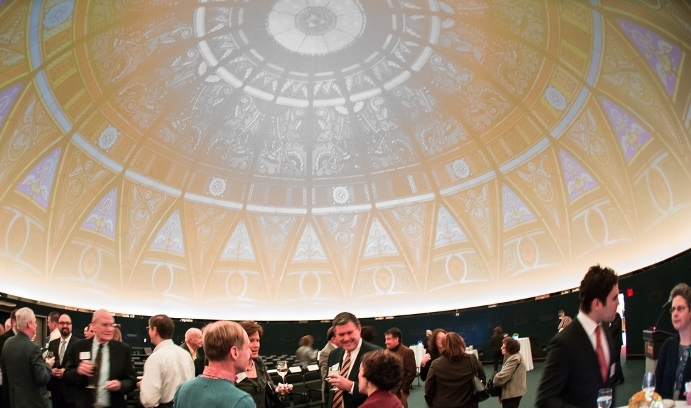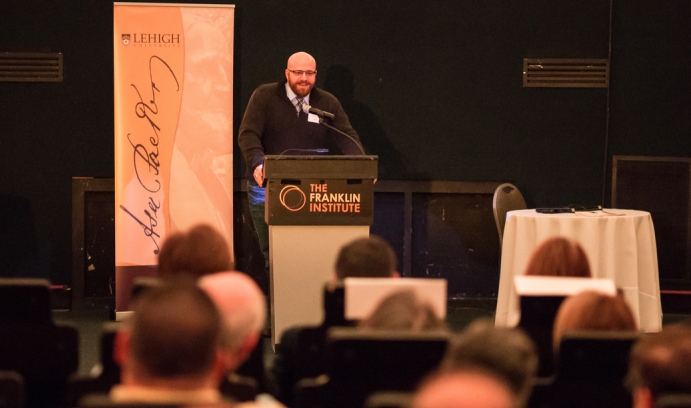Are we alone in the universe?

During a reception after Joshua Pepper’s talk at the Franklin Institute, the stained glass image from the rotunda of Linderman Library, was projected on the ceiling of the Fels Planetarium.
Joshua Pepper, an astrophysicist and assistant professor of physics, brought out the star gazer in his audience last week when he presented “How to Discover a Planet in Three (Not So Easy) Steps” at the Franklin Institute’s Fels Planetarium in Philadelphia.
Before an Asa Packer Society event with almost 100 alumni and friends, Pepper gave an astronomer’s insight into the mysteries of the solar system, with a focus on planet discovery and its implications.
Pepper, who created the Kilodegree Extremely Little Telescope (KELT), has discovered seven exoplanets, or planets that are orbiting another sun or star within our galaxy.
He’s confident that he’ll find more.
“As time goes on, we are going to understand more about these exoplanets and ultimately answer the fundamental question, ‘Are we alone in the universe?’” he said.
Pepper built the first KELT telescope as a Ph.D. student in astronomy at Ohio State University (OSU), and a second one as a postdoctoral student at Vanderbilt University. The first telescope is now located in Arizona, while the second is in South Africa. The telescopes have small lenses, only two inches wide, that precisely measure the brightness of millions of stars.
Because the stars that KELT observes are so brilliant, Pepper did not need the kind of large telescope that is more commonly used in astronomy. His focus on the small bucks the trend of bigger is better in astronomy.
“For many, many years in astronomy, there was aperture envy where everyone was trying to build bigger and bigger telescopes,” said Pepper. With the successful identification of exoplanets with KELT, Pepper is redefining how humans search the stars.
His work is not going unnoticed. Pepper is a member of the science team for the NASA Explorer Program’s Transiting Exoplanet Survey Satellite (TESS), which is scheduled to launch in five years. Run through MIT and Harvard, the TESS program will help determine which stars are the best targets to find planets that could be probed for the presence of living things.
Pepper was introduced by Lehigh President Alice P. Gast and Donald Hall, the Herbert J. and Ann L. Siegel Dean of the College of Arts and Sciences. His presentation led to a lengthy question-and-answer period with the audience, and he won praise for his ability to simplify scientific information.
“I was impressed by how the professor took very complicated concepts, boiled them down in ways that most of us could understand and made them very interesting,” said Brian Kearns ’88.
Finding A Planet 101, Step one: Measure the stars
“Wobble” and “dip,” Pepper said, are two key identifiers in finding an exoplanet. A star’s wobble is caused by the gravitational back-and-forth pull that a planet triggers. A wobble alone is not an easy method for discovering planets because it requires exquisitely precise measurements of something that is millions of light years away.
That is where the dip and Pepper’s KELT invention come in. In Arizona and South Africa, Pepper’s telescopes are scanning the sky nightly looking for a block or “dip” in the light path of a star. A dip is caused when a planet that is orbiting a star blocks that star’s light path to the earth.
Step two: Confirm the detections
Out of every 40 to 50 stars that the KELT survey identifies as a possible exoplanet, only eight to 10 meet additional criteria to be further examined. As founder of the KELT survey, Pepper works with collaborators from OSU and Vanderbilt and with amateur astronomers around the world to analyze KELT data with larger telescopes and try to determine if a planet is present.
Step three: Back to the wobble
The mass of a planet is the true gravitational catalyst of a star’s wobble. By measuring the curve of the wobble after confirming that a star is being orbited by a planet, astronomers can verify that the planet does exist.
What’s Next?
Because of technological advances over the last 20 years, Pepper said that at least 770 exoplanets orbiting other stars have been discovered and thousands of possible other candidate planets are waiting positive identification.
“Our galaxy, the Milky Way, has about 200 billion stars,” he said. “For almost all of human history, when we looked out at those stars, we could only imagine what was happening on those planets. The first step in finding extraterrestrial life is finding a planet which has a solid surface and an atmosphere where the temperature of the planet is just right for water.”
Pepper concluded by thanking guests for their support, both as Asa Packer Society members and as taxpayers, in providing resources to continue this research.
“We are at the very beginning of the process, and it will take generations before we get solid answers,” he said. “What I can teach students is how we are going to start searching for life on other worlds…what kind of telescopes we will need and what kind of planets we are searching for. It is so interdisciplinary. It combines aspects of astronomy, physics, geology, biology, chemistry, and meteorology.”
“When Josh began at Lehigh, I knew that we had a true star on our hands,” said Hall. “I know that our alums are energized when they learn exactly how much cutting-edge work is happening at Lehigh.”
Bob Brown ’78, a member of the university’s board of trustees and also of the Asa Packer Society, said, “These events keep us up to date on all the good things Lehigh is doing to increase the value of our degrees.”
For information on becoming a member of the Asa Packer Society, call 610-758- 5071 or email asapackersociety@lehigh.edu. Society members receive exclusive invitations to events that address current issues.
Photos by John Kish IV
Before an Asa Packer Society event with almost 100 alumni and friends, Pepper gave an astronomer’s insight into the mysteries of the solar system, with a focus on planet discovery and its implications.
Pepper, who created the Kilodegree Extremely Little Telescope (KELT), has discovered seven exoplanets, or planets that are orbiting another sun or star within our galaxy.
He’s confident that he’ll find more.
“As time goes on, we are going to understand more about these exoplanets and ultimately answer the fundamental question, ‘Are we alone in the universe?’” he said.
Pepper built the first KELT telescope as a Ph.D. student in astronomy at Ohio State University (OSU), and a second one as a postdoctoral student at Vanderbilt University. The first telescope is now located in Arizona, while the second is in South Africa. The telescopes have small lenses, only two inches wide, that precisely measure the brightness of millions of stars.
Because the stars that KELT observes are so brilliant, Pepper did not need the kind of large telescope that is more commonly used in astronomy. His focus on the small bucks the trend of bigger is better in astronomy.
“For many, many years in astronomy, there was aperture envy where everyone was trying to build bigger and bigger telescopes,” said Pepper. With the successful identification of exoplanets with KELT, Pepper is redefining how humans search the stars.
His work is not going unnoticed. Pepper is a member of the science team for the NASA Explorer Program’s Transiting Exoplanet Survey Satellite (TESS), which is scheduled to launch in five years. Run through MIT and Harvard, the TESS program will help determine which stars are the best targets to find planets that could be probed for the presence of living things.
Pepper was introduced by Lehigh President Alice P. Gast and Donald Hall, the Herbert J. and Ann L. Siegel Dean of the College of Arts and Sciences. His presentation led to a lengthy question-and-answer period with the audience, and he won praise for his ability to simplify scientific information.
“I was impressed by how the professor took very complicated concepts, boiled them down in ways that most of us could understand and made them very interesting,” said Brian Kearns ’88.
Finding A Planet 101, Step one: Measure the stars
“Wobble” and “dip,” Pepper said, are two key identifiers in finding an exoplanet. A star’s wobble is caused by the gravitational back-and-forth pull that a planet triggers. A wobble alone is not an easy method for discovering planets because it requires exquisitely precise measurements of something that is millions of light years away.
That is where the dip and Pepper’s KELT invention come in. In Arizona and South Africa, Pepper’s telescopes are scanning the sky nightly looking for a block or “dip” in the light path of a star. A dip is caused when a planet that is orbiting a star blocks that star’s light path to the earth.
Step two: Confirm the detections
Out of every 40 to 50 stars that the KELT survey identifies as a possible exoplanet, only eight to 10 meet additional criteria to be further examined. As founder of the KELT survey, Pepper works with collaborators from OSU and Vanderbilt and with amateur astronomers around the world to analyze KELT data with larger telescopes and try to determine if a planet is present.
Step three: Back to the wobble
The mass of a planet is the true gravitational catalyst of a star’s wobble. By measuring the curve of the wobble after confirming that a star is being orbited by a planet, astronomers can verify that the planet does exist.
What’s Next?
Because of technological advances over the last 20 years, Pepper said that at least 770 exoplanets orbiting other stars have been discovered and thousands of possible other candidate planets are waiting positive identification.
“Our galaxy, the Milky Way, has about 200 billion stars,” he said. “For almost all of human history, when we looked out at those stars, we could only imagine what was happening on those planets. The first step in finding extraterrestrial life is finding a planet which has a solid surface and an atmosphere where the temperature of the planet is just right for water.”
Pepper concluded by thanking guests for their support, both as Asa Packer Society members and as taxpayers, in providing resources to continue this research.
“We are at the very beginning of the process, and it will take generations before we get solid answers,” he said. “What I can teach students is how we are going to start searching for life on other worlds…what kind of telescopes we will need and what kind of planets we are searching for. It is so interdisciplinary. It combines aspects of astronomy, physics, geology, biology, chemistry, and meteorology.”
“When Josh began at Lehigh, I knew that we had a true star on our hands,” said Hall. “I know that our alums are energized when they learn exactly how much cutting-edge work is happening at Lehigh.”
Bob Brown ’78, a member of the university’s board of trustees and also of the Asa Packer Society, said, “These events keep us up to date on all the good things Lehigh is doing to increase the value of our degrees.”
For information on becoming a member of the Asa Packer Society, call 610-758- 5071 or email asapackersociety@lehigh.edu. Society members receive exclusive invitations to events that address current issues.
Photos by John Kish IV
Posted on:
Tuesday, February 18, 2014


